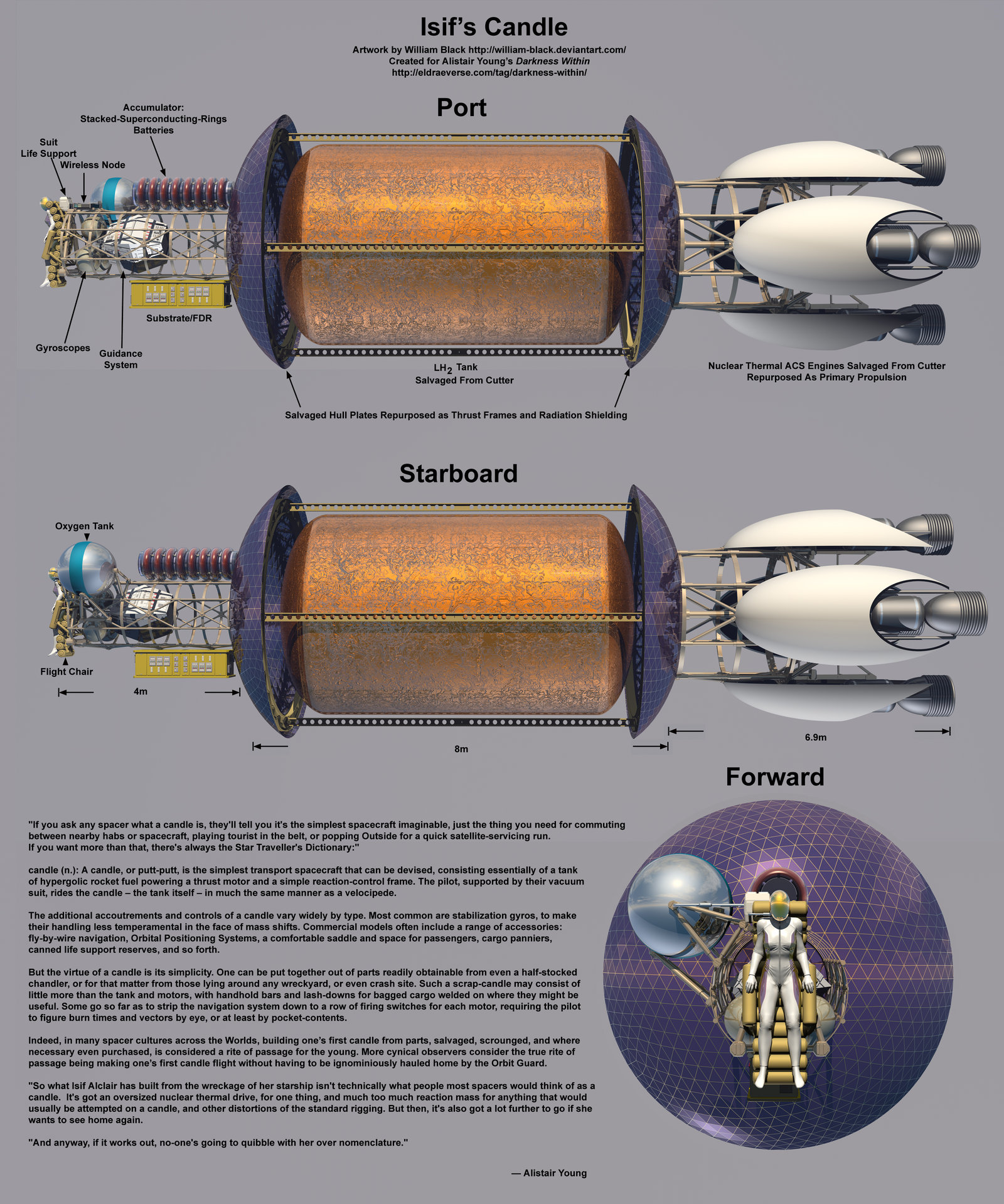Inspired by a passing comment on the Eldraeverse Discord, we now present a galari starship, the Sapphire Coloratura-class polis yacht; the favored interplanetary and interstellar transport of all sophont rocks of wealth and taste.
SAPPHIRE COLORATURA-CLASS POLIS YACHT
Operated by: Galari groups requiring luxurious private transit.
Type: Executive polis yacht.
Construction: Barycenter Yards, Galáré System
Length: 96 m (not including spinnaker)
Beam: 12 m (not including radiators)
Gravity-well capable: No.
Atmosphere-capable: No.
Personnel: None required (craft is self-sophont). Can carry an effectively arbitrary number of infomorph passengers.
Main Drive: Custom “dangle drive”; inertially-confined fusion pellets are detonated behind a leading spinnaker, the resulting thrust being transferred to the starship via a tether.
Maneuvering Drive: High-thrust ACS powered by direct venting of fusion plasma from power reactors; auxiliary cold-gas thrusters.
Propellant: Deuterium/helium-3 blend (pelletized aboard for main drive).
Cruising (sustainable) thrust: 7.2 standard gravities
Peak (unsustainable) thrust: 7.5 standard gravities
Maximum velocity: 0.12 c (based on particle shielding)
Drones:
4 x galari body-crystals; since the galari are ergovores, any galari passenger or AI system may use these for EVA purposes.
Sensors:
1 x standard navigational sensor suite, Barycenter Yards
1 x lidar grid and high-sensitivity communications laser grid, Barycenter Yards
Weapons:
Laser point-defense grid.
Other Systems:
- Cilmínár Spaceworks navigational kinetic barrier system
- 4 x Bright Shadow secondary flight control systems
- Kaloré Gravity Products type 1MP vector-control core
- Systemic Integrated Technologies flux-pinned superthermal radiator system
Small craft:
5 x minipoleis (no independent drive systems; local accumulators only)
DESIGN
The Sapphire Coloratura was intended to be a shining jewel in the crown of galari starship design, so it is perhaps fitting that it indeed resembles a shining jewel, the translucent crystal of its main body throwing sparkles of rainbow light everywhere when it chooses to fly close to stars, or when it is illuminated by the fiery blasts of its main drive.
The main body of the ship is similar to, in many ways, the galari themselves; a sixteen-faceted crystal, with eight long facets facing forward to the bow tip, and short, blunter facets facing aft towards the mechanical section, a gleaming metal cylinder with a rounded-off end taking up the remaining two-thirds of the starship’s length.
To proceed from fore to aft, the bow tip of the ship is capped with metal, housing the core mechanisms of the dangle drive; the sail deployment system, tether terminus, pellet launcher, and ignition lasers.
From our Earth perspective, this drive is very similar to the Medusa-type Orion; thrust is delivered to the starship via a 216 m diameter spinnaker “sail” on a tether ahead of the craft. Rather than dedicated pulse units, the drive projects pelletized D-3He charges ahead of the craft to the focal point of the spinnaker, where inertially-confined fusion is initiated by the ignition lasers, reflected to surround the pellet by the inner surface of the spinnaker. The resulting nuclear-pulse detonation accelerates the craft, smoothed out by the stroke cycle of the tether (see above link).
The main crystal body of the craft is essentially a solid-state piece – save for cooling labyrinths and the axial passage required by the drive – of galari thought-crystal: a substrate which holds the ship’s own intelligence, those of all passengers and any crew needed, along with whatever virtual realms, simulation spaces, or other computational matrices they may require. As such, there is little that can be described by way of an internal layout; most polis-yachts are unique in this respect.
The “waist” – broadest point – of the body is girdled by a machinery ring, containing within it the four fusion power reactors (multiple small reactors were preferred for extra redundancy by the designer) with the associated ACS, and at points between them, the backup flight control systems, navigational sensor suite, and other small auxiliary machinery.
At the aftmost point of the main body, where the blunter end of the crystal joins the mechanical section, eight crystal spikes project, symmetrically, from the point of junction. These are left hollow by the manufacturer and equipped with tip airlocks to provide a small amount of volume for cargo space and aftermarket customization; if non-ergovore passengers are expected, two of these are typically converted into quarters and life-support. A central chamber where the spikes meet serves as a body and robot hotel.
Entering the mechanical section, an accessible chamber at the forward end of the cylinder provides accommodation for the vector-control core and larger auxiliary machinery, including the thermal control system. The remainder of the section is entirely made up of bunkerage for the reactors and main drive.
The galari have never, it should be noted, shied away from making maximal use of vector control technology. This is particularly notable in the Sapphire Coloratura‘s design in two areas:
First, its radiators, which cloak the center of the mechanical section with a divided cylinder of gridwork, individual carbon-foam emitting elements held together and in place away from the hull by vector-magnetic couples, linked back to the ship itself only by the ribbons of thermal superconductor transmitting waste heat to them; and
Second, by the minipoleis that the Coloratura uses as small craft. Resembling nothing so much as miniature duplicates of the starship’s main body, these auxiliary blocks of thought-crystal are held in place orbiting the main body of the ship – often in complex patterns, even under full acceleration – connected only by vector-magnetic couples and whisker-laser communication.
That is pure ostentation.


